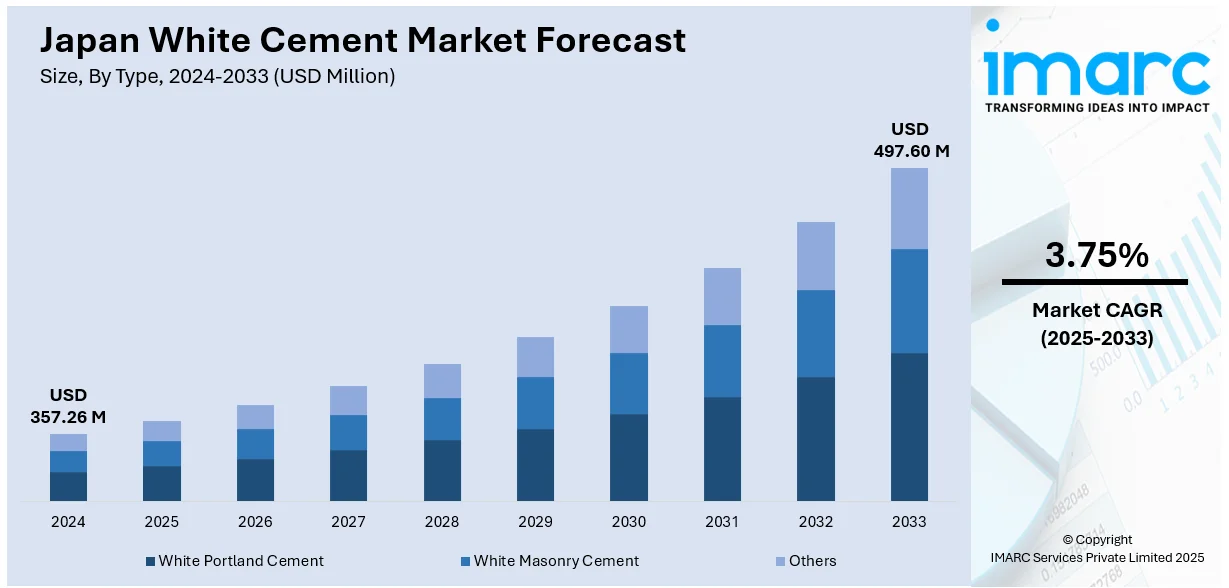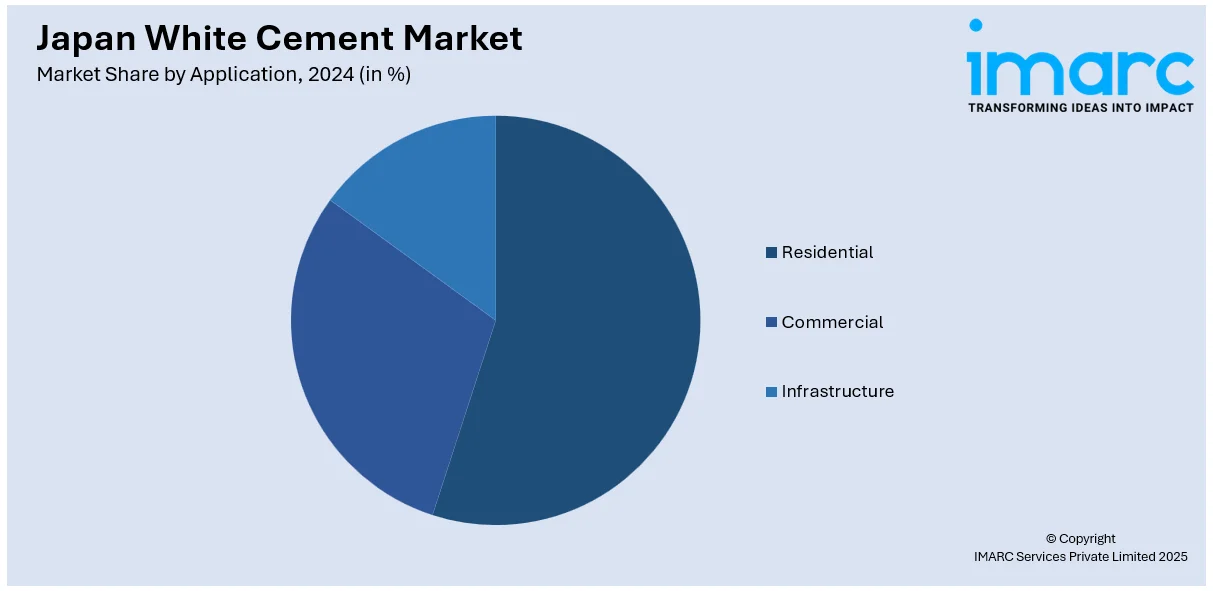
Japan White Cement Market Size, Share, Trends and Forecast by Type, Application, and Region, 2025-2033
Japan White Cement Market Overview:
The Japan white cement market size reached USD 357.26 Million in 2024. Looking forward, IMARC Group expects the market to reach USD 497.60 Million by 2033, exhibiting a growth rate (CAGR) of 3.75% during 2025-2033. Growing demand for durable architectural coatings, rise in multifunctional additives for sustainability, increased regulatory compliance for safer formulations, innovation in automotive surface technologies, greater need for specialty additives in lightweight vehicles, expansion of custom finish options, emphasis on low-emission production methods, and sustained investments in coating R&D are some of the factors positively impacting the Japan white cement market share.
|
Report Attribute
|
Key Statistics
|
|---|---|
|
Base Year
|
2024 |
|
Forecast Years
|
2025-2033
|
|
Historical Years
|
2019-2024
|
| Market Size in 2024 | USD 357.26 Million |
| Market Forecast in 2033 | USD 497.60 Million |
| Market Growth Rate 2025-2033 | 3.75% |
Japan White Cement Market Trends:
Rising Integration in Public Infrastructure and Urban Redevelopment
Japan’s ambitious urban redevelopment initiatives and public infrastructure upgrades are increasingly incorporating white cement as a preferred material. Government projects aimed at revitalizing aging urban districts, improving transportation hubs, and modernizing public spaces often specify white cement for its aesthetic qualities, durability, and low maintenance requirements. Its ability to enhance brightness, improve visibility, and create visually cohesive environments is highly valued in urban design. Significant redevelopment projects across cities such as Tokyo, Fukuoka, and Sapporo are embracing white cement in constructing pedestrian pathways, plazas, parks, and cultural centers. Public-sector architects and urban planners are increasingly selecting white cement to meet both functional and environmental objectives, reinforcing its growing role in Japan’s built environment. As cities continue to modernize and prioritize energy-efficient, sustainable materials, white cement's integration into infrastructure projects is expected to expand substantially, further driving its market potential across diverse public construction initiatives.

Automotive Sector Innovation and Specialized Coating Needs
The automotive sector remains a critical force driving the growth of the market. Major automotive manufacturers are advancing vehicle designs requiring coatings that deliver exceptional finish quality, chemical resistance, scratch resistance, and thermal management. These evolving performance standards necessitate a new generation of specialized additives tailored to meet both aesthetic and functional demands. According to analysts tracking Japan paints and coatings additives market trends, the Japan paints and coatings additives market growth is strongly tied to lightweighting initiatives and electric vehicle production. New substrate materials such as composites and aluminum call for highly engineered additives to ensure coating adhesion and performance longevity. Additionally, growing consumer interest in custom vehicle finishes, such as matte, metallic, and self-healing coatings, is creating further specialization within the additives domain. Environmental pressures also play a substantial role. Automotive manufacturers are under continuous scrutiny to minimize their environmental impact, encouraging the use of additives that facilitate lower curing temperatures, reduced solvent emissions, and extended coating durability. The market outlook remains positive, bolstered by continuous investment in R&D, the automotive industry’s emphasis on innovation, and a broader move toward sustainable, high-performance coatings systems that meet future mobility trends.
Growing Demand for High-Performance Architectural Coatings
Japan’s demand for high-performance architectural coatings is significantly influencing the paints and coatings additives sector. Modern residential and commercial structures require coatings with enhanced durability, weather resistance, and self-cleaning properties. A key feature in Japan paints and coatings additives market trends is the integration of multifunctional additives that provide anti-microbial protection, UV resistance, and energy efficiency. The market forecast highlights a stable increase in additive consumption, particularly those supporting environmentally responsible formulations such as low-VOC, waterborne, and solvent-free systems. Builders and developers are increasingly prioritizing coatings that contribute to indoor air quality and energy conservation, in line with national sustainability goals. Additionally, stringent regulatory standards around building materials are compelling manufacturers to innovate with safer, high-efficiency additives. Technologies enabling hydrophobic, anti-graffiti, and thermal insulation properties are gaining momentum, particularly in premium real estate segments. The increasing collaboration between domestic chemical companies and global specialty additives firms is further accelerating product development, creating a dynamic landscape where innovation, compliance, and performance are paramount drivers.
Japan White Cement Market Segmentation:
IMARC Group provides an analysis of the key trends in each segment of the market, along with forecasts at the country and regional levels for 2025-2033. Our report has categorized the market based on type and application.
Type Insights:
- White Portland Cement
- White Masonry Cement
- Others
The report has provided a detailed breakup and analysis of the market based on the type. This includes white Portland cement, white masonry cement, and others.
Application Insights:

- Residential
- Commercial
- Infrastructure
The report has provided a detailed breakup and analysis of the market based on the application. This includes residential, commercial, and infrastructure.
Regional Insights:
- Kanto Region
- Kansai/Kinki Region
- Central/Chubu Region
- Kyushu-Okinawa Region
- Tohoku Region
- Chugoku Region
- Hokkaido Region
- Shikoku Region
The report has also provided a comprehensive analysis of all the major regional markets, which include Kanto Region, Kansai/Kinki Region, Central/Chubu Region, Kyushu-Okinawa Region, Tohoku Region, Chugoku Region, Hokkaido Region, and Shikoku Region.
Competitive Landscape:
The market research report has also provided a comprehensive analysis of the competitive landscape. Competitive analysis such as market structure, key player positioning, top winning strategies, competitive dashboard, and company evaluation quadrant has been covered in the report. Also, detailed profiles of all major companies have been provided.
Japan White Cement Market Report Coverage:
| Report Features | Details |
|---|---|
| Base Year of the Analysis | 2024 |
| Historical Period | 2019-2024 |
| Forecast Period | 2025-2033 |
| Units | Million USD |
| Scope of the Report | Exploration of Historical Trends and Market Outlook, Industry Catalysts and Challenges, Segment-Wise Historical and Future Market Assessment:
|
| Types Covered | White Portland Cement, White Masonry Cement, Others |
| Applications Covered | Residential, Commercial, Infrastructure |
| Regions Covered | Kanto Region, Kansai/Kinki Region, Central/Chubu Region, Kyushu-Okinawa Region, Tohoku Region, Chugoku Region, Hokkaido Region, Shikoku Region |
| Customization Scope | 10% Free Customization |
| Post-Sale Analyst Support | 10-12 Weeks |
| Delivery Format | PDF and Excel through Email (We can also provide the editable version of the report in PPT/Word format on special request) |
Key Questions Answered in This Report:
- How has the Japan white cement market performed so far and how will it perform in the coming years?
- What is the breakup of the Japan white cement market on the basis of type?
- What is the breakup of the Japan white cement market on the basis of application?
- What is the breakup of the Japan white cement market on the basis of region?
- What are the various stages in the value chain of the Japan white cement market?
- What are the key driving factors and challenges in the Japan white cement market?
- What is the structure of the Japan white cement market and who are the key players?
- What is the degree of competition in the Japan white cement market?
Key Benefits for Stakeholders:
- IMARC’s industry report offers a comprehensive quantitative analysis of various market segments, historical and current market trends, market forecasts, and dynamics of the Japan white cement market from 2019-2033.
- The research report provides the latest information on the market drivers, challenges, and opportunities in the Japan white cement market.
- Porter's five forces analysis assist stakeholders in assessing the impact of new entrants, competitive rivalry, supplier power, buyer power, and the threat of substitution. It helps stakeholders to analyze the level of competition within the Japan white cement industry and its attractiveness.
- Competitive landscape allows stakeholders to understand their competitive environment and provides an insight into the current positions of key players in the market.
Need more help?
- Speak to our experienced analysts for insights on the current market scenarios.
- Include additional segments and countries to customize the report as per your requirement.
- Gain an unparalleled competitive advantage in your domain by understanding how to utilize the report and positively impacting your operations and revenue.
- For further assistance, please connect with our analysts.
 Request Customization
Request Customization
 Speak to an Analyst
Speak to an Analyst
 Request Brochure
Request Brochure
 Inquire Before Buying
Inquire Before Buying




.webp)




.webp)












